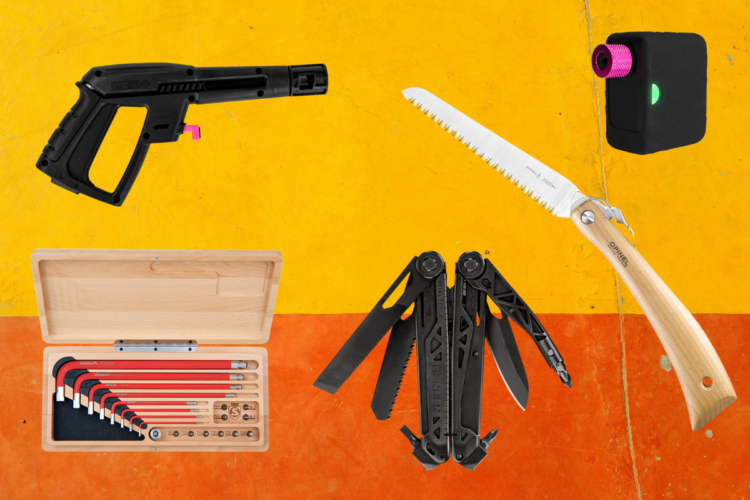
Giro had quite the launch with their new Manifest helmet, and positioned it as premium trail protection with a unique design. The Manifest uses MIPS Spherical technology, which works like a traditional MIPS liner to create a slip plane, except there’s no liner. There is a top half and a bottom half of the helmet, and the top half moves around the bottom half, like a ball and socket. There aren’t many helmets that use MIPS Spherical. Giro and Bell are the only two brands, and the Bell Super DH is one of the few helmets that incorporates it, which we reviewed last year.

The idea is that MIPS Spherical makes the helmet more comfortable, by removing the hard plastic liner from inside. The Manifest also uses an AURA arch, a translucent reinforcement between the helmet’s channels to increase the structural integrity and open up more venting.
Other features on the helmet include integrated eyewear grippers on the ceiling, in case riders’ eyes need a break during a climb, an adjustable visor which can be moved far up the helmet for goggle stowage, a rubber goggle gripper on the back of the helmet, anti-microbial padding, and a dial-operated helmet fit system called Roc-Loc. The Manifest comes in seven colors and three sizes; S, M, and L. My size medium weighs about 20g more than the claimed weight at 362g. The sticker price on the premium Manifest helmet is a hefty $260 (available at JensonUSA and other retailers).
Giro Manifest Ride impressions

I will say that the Giro Manifest is one of the comfier helmets I’ve worn in a while. Everyone’s head is different, but the Manifest feels like it wraps around my entire head, without any noticeable pressure points. Whether this has anything to do with the use of the MIPS Spherical over the plastic liner, I can’t say for sure, but I don’t mind it on my head at all.


The XT2 anti-microbial padding aids in this. The pad density feels light, but it’s voluminous and dries quickly. The overall design and venting could help with this. In their press release, Giro claims that the Manifest “runs significantly cooler,” than other mountain biker helmets. It does in fact bring in a good amount of air and moves it through the lid, but I didn’t notice a big difference from the Sweet Protection Trailblazer that I tested prior to the Manifest. At most, it feels a little more breezy inside than the Trailblazer, which also vents really well. That said, the Manifest is a great helmet for hot days on the trail, and not overly sweat-inducing.
There is room for goggle stowage on the brow of the helmet with the visor pushed up to the max, but the goggle frame will likely hang down a little bit. There are some rubber grippers on the inside of the helmet as well. I didn’t find that they helped me keep the glasses in place, but I rarely ever stow them slotted into the vents anyway.

The look of the Manifest feels a little more tame than the goggle-accommodating features and MIPS Spherical would suggest. I’m not a huge fan of the “edgy” graphics on the bottom of my black Manifest, but with six other choices, riders should have no problem finding something that they like. I do like that the Manifest sits really close to the head for a lower profile.

Lastly, let’s talk about the price. At $260, the Giro Manifest is an expensive half-shell helmet, no way around it. The full-face Smith Mainline with Koroyd and MIPS, which I also just reviewed, is just $40 more, however that’s not a perfect comparison. There isn’t anything that says MIPS Spherical is safer than a regular MIPS liner. Giro’s focus with MIPS Spherical, was to make the helmet more comfortable.
More and more studies are finding MIPS is useful and now it seems like MIPS is offering two different tiers in technology, with one option being more comfortable than the other. In this design, Giro did use two different foam densities in both the top and bottom portions of the helmet, with the top EPS foam piece a higher density than the bottom. The top piece is meant for managing high speed impacts, and the bottom is for slower speed impacts, so Giro did consider how to use MIPS Spherical for the utmost impact protection.
Closing thoughts

The Giro Manifest is a really comfortable helmet. By using MIPS Spherical, it does seem to create a more inviting home for your dome, and other features like AURA keep the air flow up inside the helmet while ensuring a level of safety. It is hard to ignore the price tag on the Manifest, however. At almost $300 for a half-shell helmet that isn’t necessarily a game changer, it’s a tough pill to swallow. Though, for those that want a helmet for trail riding that is very comfortable, with the latest iteration of MIPS, the Manifest delivers.
- Price: $195
- Available at Competitive Cyclist and other online retailers.





















1 Comments
Aug 30, 2020